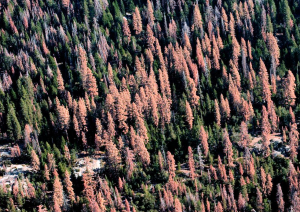By Shaye Wolf and Chad Hanson

Arial shot of a forest with trees dying from pests, pathogens, and/or climate change. Photo Credit Duke.edu
As scientists with expertise in forest and fire ecology and climate change in California, we feel compelled to expose the many false claims from the biomass industry in your May 19 article (“In California, A Push Grows to Turn Dead Trees into Biomass Energy”).
These claims fly in the face of the best available science. Creating effective forest, fire, and climate policy depends on getting the facts right.
Research shows that cutting and incinerating trees for electricity worsens the climate crisis, doesn’t protect communities from wildfires, harms forests, increases environmental injustice and diverts resources away from genuine climate solutions such as solar and wind. That’s why hundreds of scientists have told U.S. congressional leaders and the European Parliament that biomass energy will exacerbate climate change and degrade forests.
One pervasive piece of biomass industry fiction in this article is that recent tree mortality in California will cause more intense wildfires, so dead trees should be cut down. Yet numerous studies show that dead trees do not increasewildfire severityor extent.
In contrast, it’s well-established that dead trees provide vital ecological and climate benefits, including outstanding wildlife habitat and carbon storage.
Dead trees support native insect larvae that form the foundation of the forest food web, while cavities in dead trees provide great spaces for nests and dens for wildlife. In fact, areas of concentrated dead trees — called snag forests — have among the highest wildlife abundance and diversity of any forest type.
In addition, dead trees retain most of their carbon even after intense fire, providing natural carbon storage for decades or even centuries before becoming soil and contributing to the growth of new trees.
Logging and biomass companies won’t admit it, but dead trees have been in short supply due to fire suppression and clear-cutting after fires. In fact, there is an overall shortage of ecologically important snag forests compared to what existed prior to the 20th Century.
Another misleading industry claim is that cutting trees will reduce fire severity and help community fire safety. Research shows that thinning forests can actually increase fire severity and is not a good way to protect communities from wildfire.
As we pointed out in the article, the most effective way to prevent homes from igniting during wildfires is to make the houses themselves more fire safe. That includes retrofitting homes with fire-resistant roofing and vent screens and pruning vegetation in the defensible space immediately surrounding them.
A close look at other biomass industry claims in the article shows them to be similarly misleading.
Reducing carbon emissions? As research shows, thinning forests under the guise of controlling fire actually increases overall carbon emissions and reduces forest carbon storage. One study estimated that thinning can remove three times as much carbon from the forest as would be avoided in wildfire emissions. Moreover, the claims in the article about massive wildfire emissions are misleading because they heavily overstate actual carbon emissions and fail to account for rapid post-fire regrowth and carbon absorption.
Climate solution? Like coal and oil, biomass is a carbon-burning form of energy production that emits carbon dioxide and contributes to the climate crisis. In fact, biomass power plants are California’s dirtiest electricity source. They release more carbon at the smokestack than coal and leave less carbon stored in the forest.
Further, biomass industry fantasies about capturing CO2 and pumping it underground are similar to the widely discredited “clean coal” myth.
Cleaner air? Biomass power plants are among California’s worst emitters of particulate matter and other air pollutants that harm public health. Many of California’s biomass power plants are concentrated in vulnerable communities in the Central Valley, places already suffering from the nation’s worst air quality.
Job creation? Because it’s so inefficient, biomass power is California’s most expensive energy source. Biomass power plants are propped up by regulatory incentives and massive subsidies from taxpayers. These biomass subsidies take resources away from cheaper and truly clean solar and wind energy and the jobs they create. Investing instead in home fire safety work and solar and wind energy would create many more well-paying jobs, bolstering rural economies.
The facts are clear: biomass energy is a false solution.
Shaye Wolf, Ph.D., Climate Science Director
Center for Biological Diversity
Chad Hanson, Ph.D., Ecologist
John Muir Project
